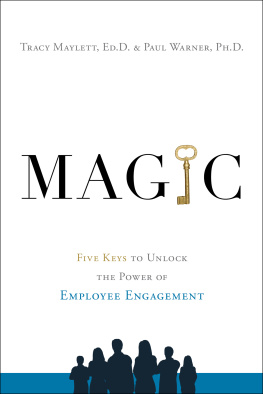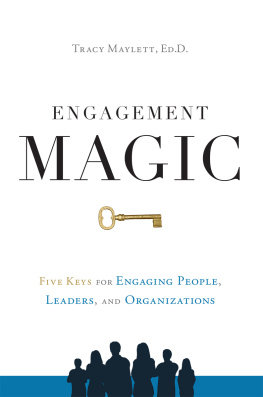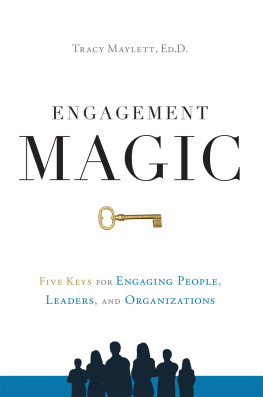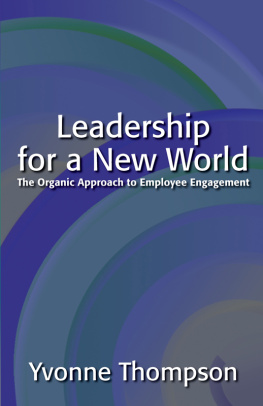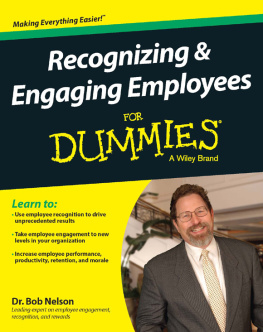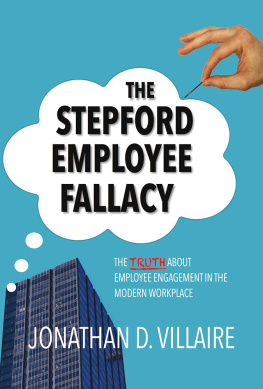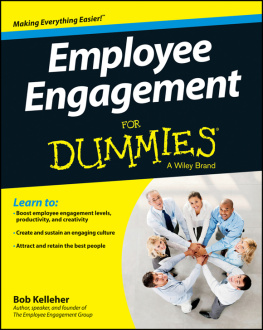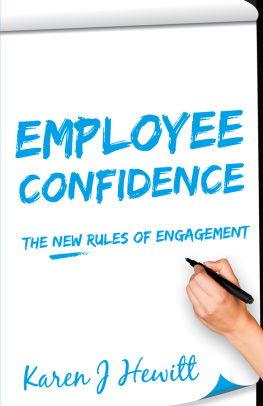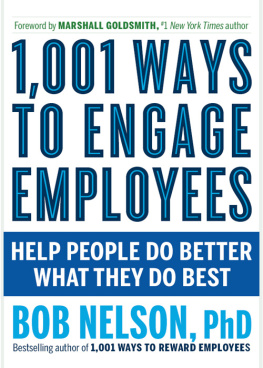
Published by Greenleaf Book Group Press
Austin, Texas
www.gbgpress.com
Copyright 2014 DecisionWise, Inc.
All rights reserved.
No part of this book may be reproduced, stored in a retrieval system, or transmitted by any means, electronic, mechanical, photocopying, recording, or otherwise, without written permission from the copyright holder.
Distributed by Greenleaf Book Group
For ordering information or special discounts for bulk purchases, please contact Greenleaf Book Group at PO Box 91869, Austin, TX 78709, 512.891.6100.
Design and composition by Greenleaf Book Group
Cover design by Greenleaf Book Group
Ebook ISBN: 978-1-62634-116-6
Ebook Edition
To our families, valued client partners, and the DecisionWise teamour magic.
CONTENTS
INTRODUCTION
IMAGINE IF ONE-THIRD of the people at your company felt that they could not speak up at work for fear of negative consequences. What would that say about your organization? Would it suggest an environment that stifles free expression? Most important, what would be the consequences of such a culture of silence?
Many organizations dont have to imagine this scenario, because its happening right under their noses. Analysis of more than 14 million DecisionWise Employee Engagement Assessments revealed something shocking: 34 percent of all employees are afraid to speak up at work because they believe they will be subject to retribution. Thats a major symptom of disengagement. And what if you were one of these employeesor have you been there, done that?
The outcome? Impaired innovation, reduced safety, and poorer-quality work, for starters. When employees cant speak up about dysfunctional policies or processes, they wind up feeling powerless to direct their work in a way that makes the company competitive.
Okay, so what happens when employees are fully engaged in their work? When we analyzed the publicly traded companies that scored in the top 10 percent and bottom 10 percent of our Employee Engagement Assessments, the results were just as dramatic but a lot more favorable. The companies that scored in the top 10 percent in employee engagement were considerably more profitable, grew faster, and had lower turnover than the companies in the bottom 10 percent.
Example: CHG Healthcare Services is at the top of our list with an incredible engagement score that consistently exceeds 90 percent (meaning that over 90 percent of survey question responses are favorable). They have been ranked as high as number three on Fortunes 100 Best Companies to Work For list, in the same league as titans like Google and SAS. They are the most profitable company in the health-care-staffing industry.
However, before CHG launched its Putting People First program and transformed its moderately engaged corporate culture, the companys turnover rate was negatively impacting growth. Today, turnover is half the industry average, and CHG even managed to grow revenue and profits during the 20082011 recession while their industry peers saw profitability plummet.
THE CHEESECAKE FACTORY
CHG Healthcare Services didnt change on a dime. It took extensive planning, conscious effort, hard work by leaders and teams, and consistent follow-through to gain the trust of employees and transform the companys culture. But the results speak for themselves.
The Cheesecake Factory, Inc., also experienced firsthand the power of employee engagement in changing the trajectory of a business. One of the most popular restaurant chains in the United States (and now a player on the global restaurant scene), The Cheesecake Factory, Inc., operates more than 180 restaurants. The company regularly conducts engagement surveys throughout these locations, and correlates employee engagement scores with business outcomes like attrition and guest (customer) satisfaction. The Cheesecake Factory, Inc., restaurants with the most engaged employees have consistently strong marks for quality, the highest levels of guest satisfaction and, not surprisingly, the lowest turnover. Simply put, theyre great environments to work in, and their guests take notice.
WE CANT GET NO SATISFACTION
With results like those, its no wonder that organizations around the world are investing heavily in order to find ways to get employees more engaged. The trouble is, theyre wasting most of that money. According to a 2012 report produced by research firm Bersin by Deloitte, entitled Employee
Yet by most accounts, employee engagement at work is at dangerously low levels. Depending on the source, youll read that anywhere from 63 to 70 percent of American workers are not fully engaged in their jobs, and results are similar outside the United States. Want to keep yourself up at night? Read Gallups State of the American Workplace Report: 20102012, which insists that fully 18 percent of workers are actively disengaged at work and every day from nine to five are actively sabotaging their employers businesses.
We dont put a lot of stock in this sort of hand-wringing data (for reasons well explain later), but they do drive home two important points:
- In the wake of the Great Recession, there is a serious problem with employee engagement in the United States, and that problem is echoed across the globe.
- Companies are spending a lot of money trying to drive engagement, but all theyre really doing is measuring it year to year, rather than impacting it. Theyre not getting much for their investment.
Even more telling is the finding, also from the Bersin report, that employers cant even agree on what engagement is or what it looks like when employees are more engaged. So, were spending three-quarters of a billion dollars a year to cultivate something without knowing what it is. Is anybody surprised that most of those efforts fail?
One of the biggest reasons for that failure is that while organizations think they are enacting programs to increase employee engagement, their changes are really all about employee satisfaction. Engagement and satisfaction are not the same. When you install an espresso machine in every break room, provide each floor with its own air-hockey table, and open an onsite gym, you might get a temporary bump in employee satisfaction. But it doesnt last. You dont win hearts and minds with shade-grown coffee and arcade games.
Most organizations dont understand engagement, so they cant create it. One of the biggest misapprehensions is that engagement is something the organization imposes on employeesthat its transactional. If I give you this, that, and the other, youll become engaged in your work.
And this is another reason most engagement efforts failthey assume the responsibility for engagement rests solely on the shoulders of the organization. But in reality, engagement is a 50-50 propositiona two-way street. Yes, the organization is responsible for creating an environment where engagement can flourishtilling and amending the soil so that engagement can grow, so to speak. But the employee has an equal responsibility to be engaged. Engagement is collaborative: Management must create the opportunities to find meaning, connection, and self-actualization at work, but its up to the employee to say, Im in!
THE PURPOSE OF THIS BOOK
Weve written this book as a tool to help both employers and employees shed the many fallacies and myths about engagement and learn to leverage it for what it is: a secret weapon that, when unlocked, can turn a faltering company into a healthy one and a good organization into a great one.
Next page
